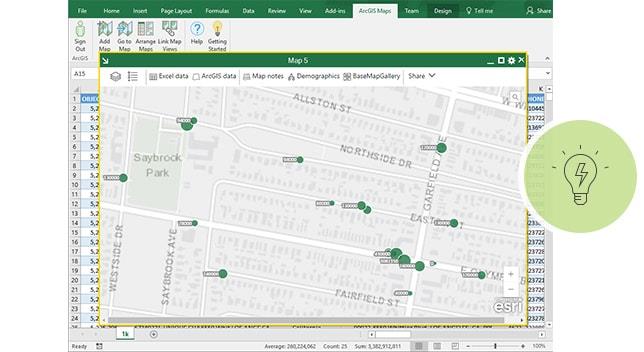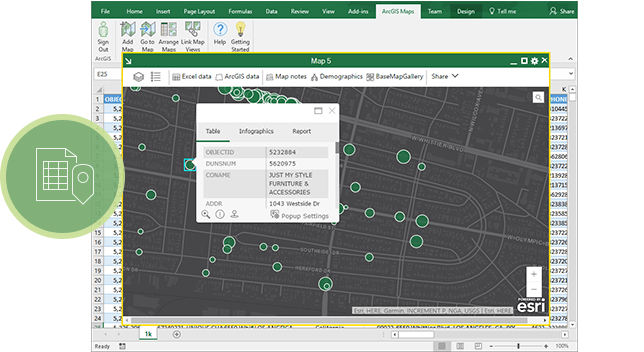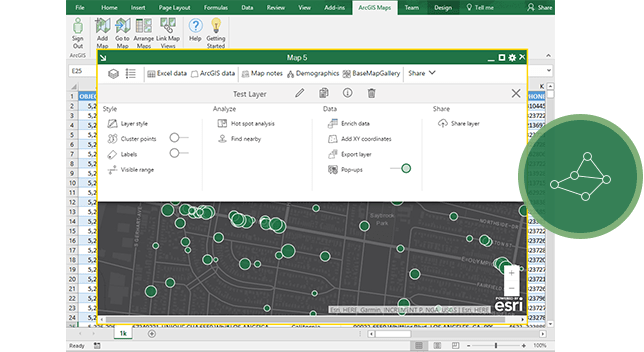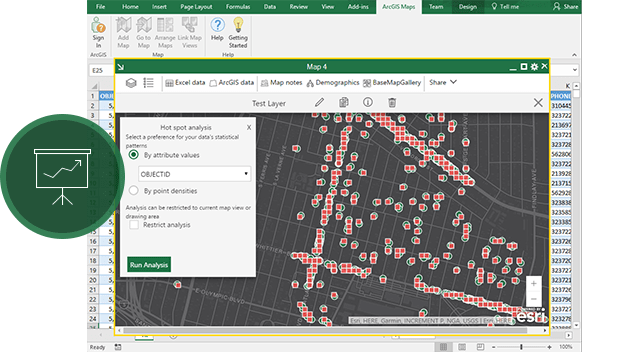Interactive maps in your spreadsheets and presentations
Spreadsheets and graphs bring data to life. Now, you can use maps to see data from another perspective. ArcGIS Maps for Office puts Microsoft Excel data in context of location. You will see patterns and relationships to better understand a situation and make smarter decisions. Then, use Microsoft PowerPoint to share the results.
Add location intelligence

1.Maximize your information
Map your data to extract maximum value by asking a whole new set of location-related questions. Gain new perspectives you’ve been missing.
2.Work with trusted, verified data
Augment your Excel spreadsheet data by mapping it along with layers of trusted, verified, global data on demographics, lifestyle, and geography.


3.Sync and share your work
Give your team instant access to updated, reliable information. When you sync your maps to ArcGIS, you share your work securely and widely with whomever you choose.
4.Tell more effective stories
Impress your audience when you tell your story with map-based presentations in PowerPoint. Show key locations or use the map to answer questions.

How it works
1.Start with your data
Find the data you need to create your map visualization.
2.Choose a map style
Find a style that best highlights your data for maximum show and tell.
3.See patterns, gain understanding
Interpret trends and relationships in your data to make better decisions.
4.Tell your story
Share the maps you made, with stakeholders and the public.
Interactive maps in your spreadsheets and presentations
Spreadsheets and graphs bring data to life. Now, you can use maps to see data from another perspective. ArcGIS Maps for Office puts Microsoft Excel data in context of location. You will see patterns and relationships to better understand a situation and make smarter decisions. Then, use Microsoft PowerPoint to share the results.
Add location intelligence
1.Maximize your information

Map your data to extract maximum value by asking a whole new set of location-related questions. Gain new perspectives you’ve been missing.
2.Work with trusted, verified data

Augment your Excel spreadsheet data by mapping it along with layers of trusted, verified, global data on demographics, lifestyle, and geography.
3.Sync and share your work

Give your team instant access to updated, reliable information. When you sync your maps to ArcGIS, you share your work securely and widely with whomever you choose.
4.Tell more effective stories

Impress your audience when you tell your story with map-based presentations in PowerPoint. Show key locations or use the map to answer questions.
How it works
1.Start with your data
Find the data you need to create your map visualization.
2.Choose a map style
Find a style that best highlights your data for maximum show and tell.
3.See patterns, gain understanding
Interpret trends and relationships in your data to make better decisions.
4.Tell your story
Share the maps you made, with stakeholders and the public.
